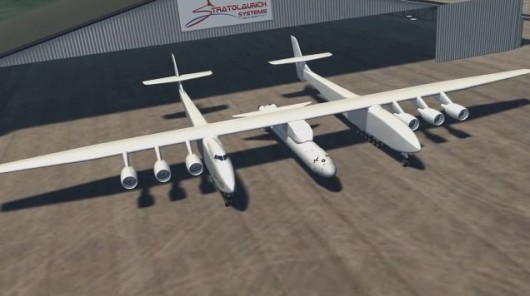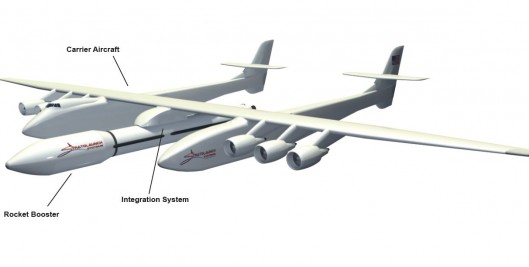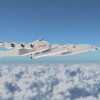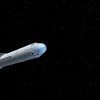Stratolaunch Systems announces "a radical change in the space launch industry"
By Ben Coxworth
13:07 December 13, 2011

Stratolaunch Systems has announced its planned air-launch-to-orbit system, which will get spacecraft into orbit using the largest aircraft ever flown
Seven years ago, philanthropist Paul G. Allen collaborated with aerospace expert Burt Rutan, to create SpaceShipOne - the first privately-funded, manned rocket ship to fly beyond Earth's atmosphere, and winner of the Ansari X PRIZE. Now, in the post-Shuttle era, the two men have reunited to create a reusable vehicle for launching both manned and unmanned rockets into space. The project was announced in Seattle today.
Allen and Rutan's new company, Stratolaunch Systems, will be developing a mobile launch system consisting of three main components.
The first will be an enormous carrier aircraft, made by Rutan's company Scaled Composites. With a wingspan of over 380 feet (116 m), packing six 747 engines and weighing over 1.2 million pounds (544,311 kg), it will be the largest aircraft ever flown.
Mounted underneath the aircraft's SpaceShipOne-like twin bodies will be a multi-stage booster, which in turn will be attached to the spacecraft. Built by Space Exploration Technologies, this 490,000-pound (222,260-kg) booster will fire once it has been released from the aircraft, carrying the spacecraft into orbit.
The third component of the system will be a mating and integration system, which will allow the aircraft to safely carry and release its payload. It will be designed by aerospace engineering firm Dynetics.
The aircraft will be constructed in a dedicated Stratolaunch hangar, which will reportedly soon be under construction at the Mojave Air and Space Port. Hopefully, the first flight should be taking place within five years. According to the company, its air-launch-to-orbit system "will mean lower costs, greater safety, and more flexibility and responsiveness than is possible today with ground-based systems." Turnaround time between launches should also be much shorter than is currently possible, allowing for a larger number of launches within a given time period.
Once built, the aircraft will likely operate out of a large airport/spaceport, such as the Kennedy Space Center. It will require a runway at least 12,000 feet (3,658 m) long, and be able to fly to launch points up to 1,300 nautical miles (2,407 km) away.
"I have long dreamed about taking the next big step in private space flight after the success of SpaceShipOne - to offer a flexible, orbital space delivery system," Allen said today. "We are at the dawn of radical change in the space launch industry."
More details are available on the currently heavily-taxed Stratolaunch Systems website, and in the video below.



